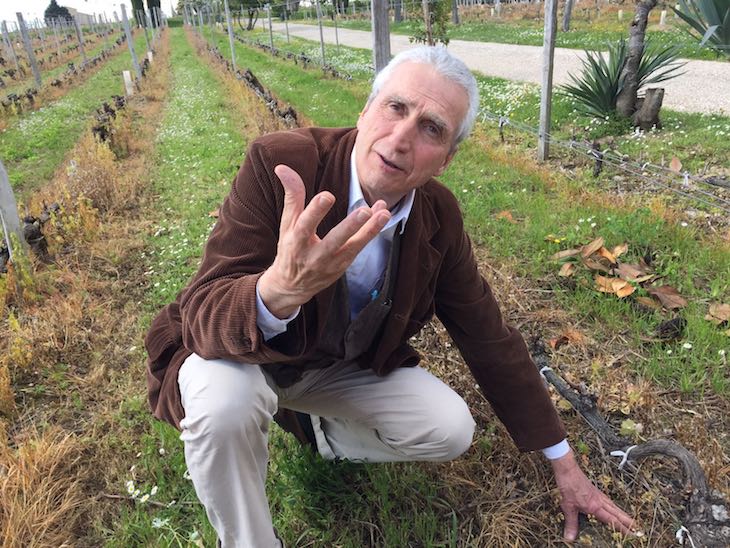
Francois Mitjavile of Chateau Le Tertre Roteboeuf.
If I were a winemaker in Bordeaux during the 2016 vintage, I would need a clear vision of the kind of wine I wanted to make. Would I green harvest to try to further concentrate my grapes? How much leaf plucking or shading do I need given the cool, wet, spring conditions creating worry frowns on my forehead? When should I harvest the different varieties to get the style that I want? How long and what type of extraction techniques should I choose, given the high tannin content in the wine? What percentage of new oak shall I use and how long should I leave it in barrel?
While these are questions that winemakers will ask themselves for every vintage, the choices made in 2016 were especially transparent.
Transparency is one of the key characteristics of this vintage. It was a vintage that defined how the chateaux see themselves. What is their identity and personality? In many vintages like 2012 or 2013, the harvest window was narrow, squeezed between forecasts of rain, botrytis or other climatic challenges. However, in 2016, harvest could have started as early as mid September and as late as end of October and conditions were favorable for early or late picking. There was a lot of room to define exactly what this vintage meant and how each château defined their ideal ripeness.
There were clear stars in this vintage: Lafite was one of them; this is one of its glorious vintages, incredibly detailed and fine with the restraint and class one expects from this chateau. Latour is the opposite — stern, dense, compact and powerful. Mouton is flamboyant but restrained during its youth and Margaux is incredibly floral and elegant. Haut-Brion is its heightened self — an aristocratic wine exuding the scent of a private cigar club. And for anyone who was ever confused (due to similar sounding names) between the personalities of Pichon Longueville Comtesse de Lalande and Pichon Longueville Baron, then deliberate no more. Taste the 2016 vintage side by side and the differences between them are like night and day — the Pichon Lalande, elegant and focused, the Baron sturdy and opulent. Both are equally enticing.
Identity dilemma
Several chateaux, like Cos d’Estournel seemed to have an identity dilemma. 2016 had the potential to make powerful, concentrated, dense wines and the team at Cos decided to make a lighter, refreshing style. This is a dramatic move away from the highly extracted, dense, ripe styles favored by Jean-Guillaume Prats when he led the property from 2001 to 2012. While its neighbors made some of the most tannic, powerful wines, Cos d’Estournel, is veering towards extremely light, denying the power and the intensity available in this vintage.
What really fascinates me about the 2016 Bordeaux is how the châteaux defined themselves. That transparent character with no excess weight (alcohols were moderate) means each property had a huge palette of flavors and options to choose from, to make huge, powerful, ripe wines or more elegant styles. At Pavie, 2016 had less extraction compared to other great years like 2009 or 2010, 10 days less to be exact, and new oak was reduced from 100% to 70%. This is the direction, the palette colors for 2016 Pavie.
This was not a clear-cut, great vintage from the onset. It was only after fermentation that many “discovered” the true quality of these wines. Eric Kohler, Technical Director of Lafite, says, “We were working so hard during the growing season and constantly worried — about rain, mildew, then not enough rain — that we really did not expect a great vintage. I was surprised [at the final result].”
Drought
Following a wet spring, over two months of drought ensued starting in July continuing through to August, with many young vines or those on very dry soils, halting growth from water stress. In 2016, the grapes matured slowly with an ideal, warm Indian summer with cool nights providing the freshness. This contributed to grapes having both concentration and purity.
At Leoville Las Cases, 2016 was the driest-ever recorded summer since 1900 with the drought lasting 80 days. Vines stopped growing and the slow maturation resulted in accumulating flavors and color in the skins. 2016 Las Cases is a collector’s item — true to its identity and reflective of a great vintage.
The 2016 vintage is clearly not as ripe and opulent as 2015 and 2009; it is closer in style to 2005 and 2010. “We can say that we have something new since 2000. In the past, either the vintage had a hot summer, early harvest, and the wines turned out great, or it was rainy and not a great growing season, but the late Indian summer made it a great vintage. Vintages like 2000, 2005, 2010 and 2016 are a new paradigm – we had dry, hot summer as well as a late warm autumn harvest. The fruit has opulence as well as freshness,” says Francois Mitjavile of Tertre Roteboeuf.
For me 2016 has an edge over the recent great vintages: Growers have had more practice at making “haute-couture” wines. The refinement and reinvestment by top chateaux to make more precise, detailed wines have been accelerating over the last ten years. Most successful wineries have moved to expensive gravity flow cellars, precise vineyard mapping using the latest technology, small vat fermentations and the critical movement in the vineyard towards labor-intensive organic, sustainable and biodynamic farming. It is only now that the results of all of these steps for greater and greater precision are manifesting itself in the wines. 2016 is a new modern classic that will definitely be part of my cellar.









